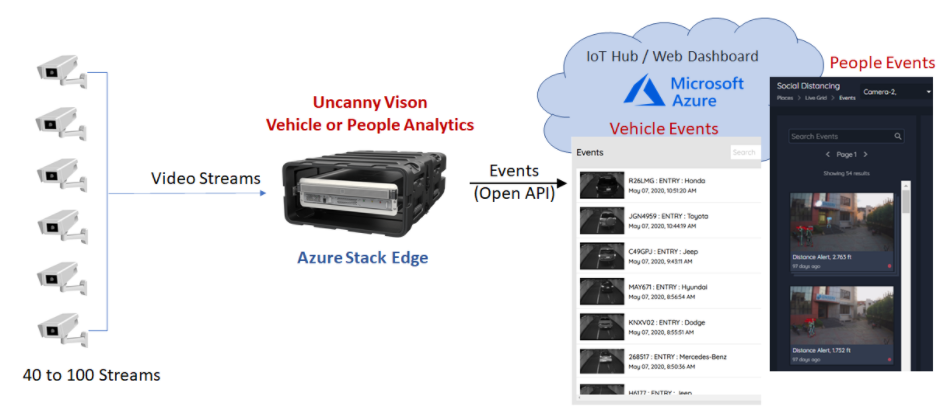Uncanny Vision People and Vehicle Analytics is now on Azure Stack Edge
Have you ever wondered why License Plate Recognition (LPR) is a Standard for Parking Access & Revenue Control in Europe but has not taken off in the US?
License Plate in the US like many other things is not standardized across different states and varies quite a bit from state to state. Many states also offer personalization of License Plate, so users put different images and characters on the License Plate making it quite hard to read License Plates using traditional computer vision techniques. Application of Artificial Intelligence (AI) to detect & track vehicles as well as to detect and read License Plates can provide significantly high accuracy. But running AI models on the cloud can quickly become quite expensive and has limited application due to higher latency.
Uncanny vision is an AI technology company that solves real world problems by using AI with a focus on the Parking, Traffic and Surveillance Industry. Parking, Traffic and Surveillance are some of the industries where Uncanny Vision has successfully applied AI.
Parking: Garages can be divided into two broad categories - Gated and Gateless. In a Gated garage RFID is a standard method for access control so far but there is quite a bit of disruption in this in the last few years. In a Gateless System there is no monitoring or enforcement if an RFID based system is used. LPR can solve problems in both a gated and gateless garage. For example, in a gateless garage, LPR can provide the occupancy of vehicles in a garage as well as provide information about the License Plate of vehicles that haven’t been paid. This enables easier and efficient enforcement. Enforcement officer’s don’t have to roam around to find violators; instead the system will alert them on the number of violations, frequency of violations with their Licence Plate details.
Traffic: Customers want to know how many vehicles pass through an intersection, what the turning movement counts are, how many pedestrians are passing, how many cyclists are there etc.,? This kind of analysis is critical for traffic planning, optimization of signal parameters and to drive traffic safety.
Surveillance: Intrusion detection, Perimeter protection are typically done using traditional computer vision algorithms sometimes within the camera or inside the NVR, but results in frequent false alarms. In many cases, the monitoring stations will receive an alarm from say a motion sensor or glass break sensor etc., and the monitoring operator has to manually look at the video footage and verify the alarm before taking corrective action. One in 100’s of those alarms will be a true positive one. However, using AI based perimeter protection and Intrusion detection system will enable operators to receive a video verified alarm with evidence image or a short video associated with that alarm. Uncanny Vision works with many Video Monitoring companies to offer them real time AI based video monitoring which improves efficiency of their operations while cutting cost at the same time.
Why is Edge Critical for such applications?
There are several reasons why running these AI applications on the edge is critical:
Low Latency
In an access control application, as soon as the customer pulls his vehicle in front of the gate, the License Plate has to be read and a decision to open the gate or not should be made in less than a second. Also the device should support offline mode of operation as network drops are expected at the edge.
Bandwidth
Sending video data over the network 24/7 can consume too much bandwidth.
Cost
Video data can take too much storage space as well as compute time on video data can get expensive
Offline mode of operation
Some use cases require devices to be operational even under loss of connectivity. Running AI on the cloud for such applications is not viable.
Why do we use Azure Stack Edge?
All features of Azure Cloud available at the edge
Enterprise Grade & Rugged
Reliable hardware
Expandable Architecture
Can handle LPR on up to 40 cameras
Has all the functionality of Azure at the edge with offline mode of operation
Hardware as a Service (HAAS)
No Capex involved with hardware purchase
High Level Architecture
LPR System Architecture


